Bagnet Ilocos recipe you’ll love with the perfect bagoong dip
Bagnet is the Holy Grail for all meat lovers. It’s a bit similar to chicharon, but the method of preparation and cooking is different.
This is a have-to-go-and-taste food when you’re in the province of Ilocos. It’s basically a slab of pork that’s deep-fried until it turns golden brown.
It’s oh so delicious! Can’t wait to make this with you!
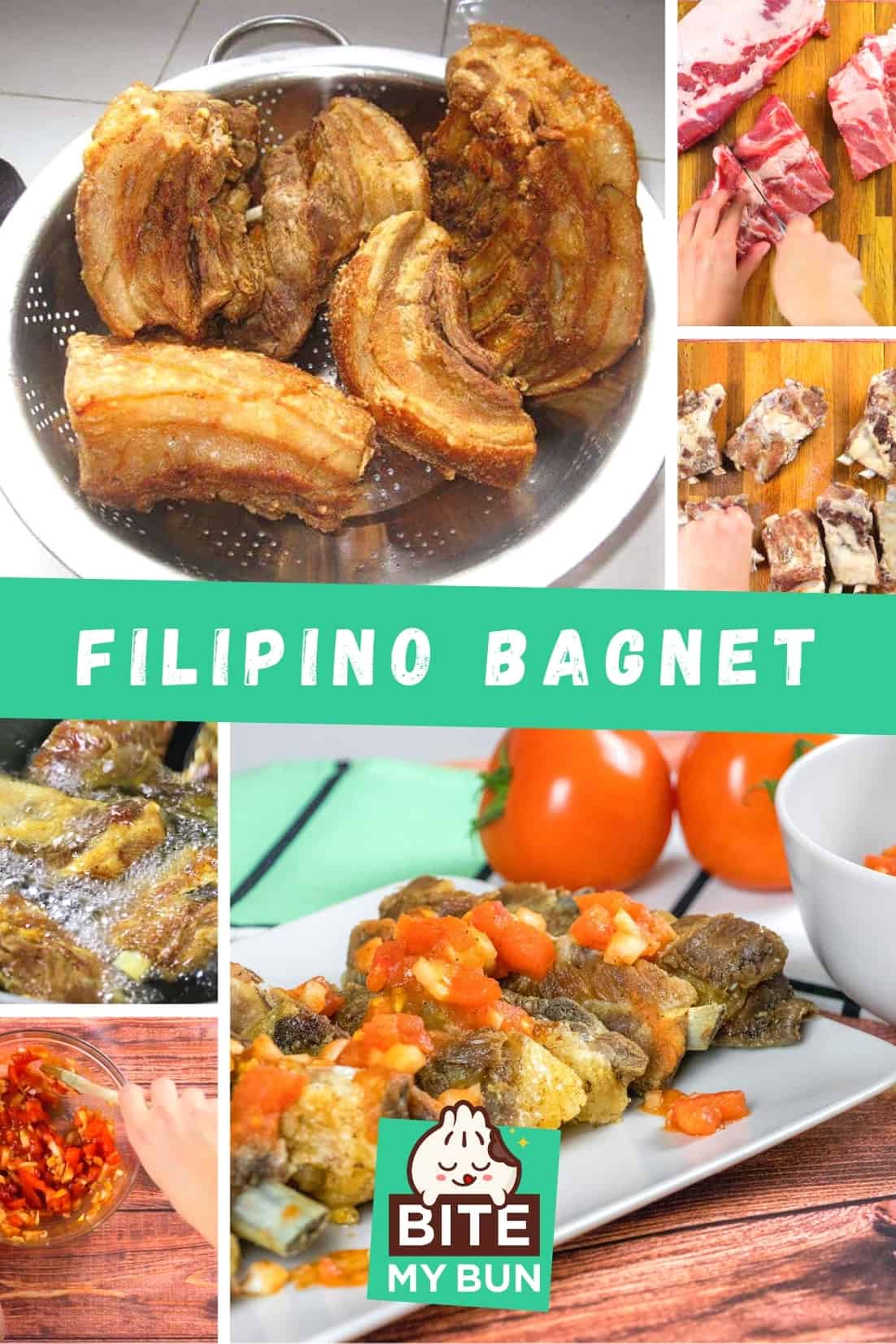

Check out our new cookbook
Bitemybun's family recipes with complete meal planner and recipe guide.
Try it out for free with Kindle Unlimited:
Read for freeIn this post we'll cover:
Bagnet recipe techniques
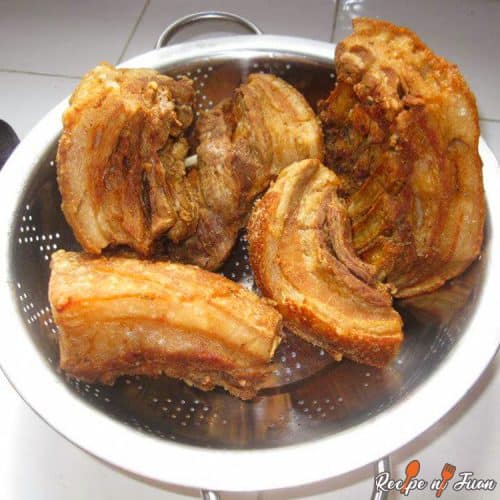
Crispy Filipino bagnet recipe with bagoong alamang tomato dip
Ingredients
- 4½ lbs pork liempo (pork belly) whole cut
- ½ head garlic
- 1 tsp peppercorns
- 2 tbsp salt
- 4 bay leaves
- cooking oil for frying
Bagoong alamang tomato dip
- 2 medium tomatoes
- 1 small red onion
- 4 tbsp bagoong alamang
- 1 lemon or 3 calamansi
- 1 pinch black pepper
Instructions
- Wash the pork belly, cut it into large chunks, and place it in a large pot.

- Add enough water to cover the pork belly.
- Add in 1 tbsp of salt, peppercorns, garlic, and bay leaf.
- Cover and bring it to a boil, then lower the heat to simmer for 45 minutes or until pork is tender. Remove all the scum that rises.

- Remove the meat from the pot and place it in a colander. Let it sit for a while so the liquid will drain. Prick the skin many times using a fork, then dry the whole thing with paper towels if necessary. Keep it refrigerated for several hours. You need to cool it all the way down for the skin to get that nice crispy texture when you fry it.
- Take the meat out of the fridge, slice it into about 4 equal 3-inch thick pieces, and rub the remaining tbsp of salt all over the meat.
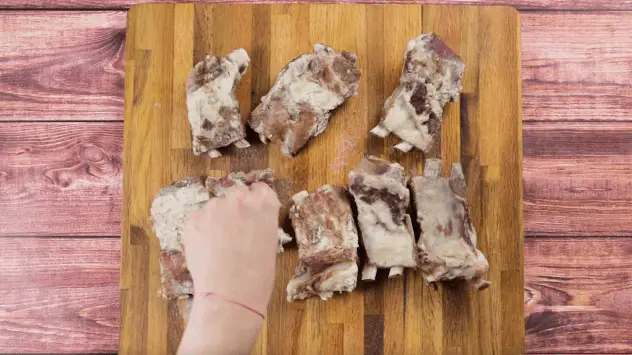
- In a large kawali, deep fryer, or a wok, heat enough cooking oil, and deep fry the pork belly at a low heat for 30 minutes or until the pork turns golden-brown. The trick here is to use a low heat so you don't get as many splashes of oil and you can fry it for a longer period of time. Chicharon or lechon kawali, for example, are fried at high heat.
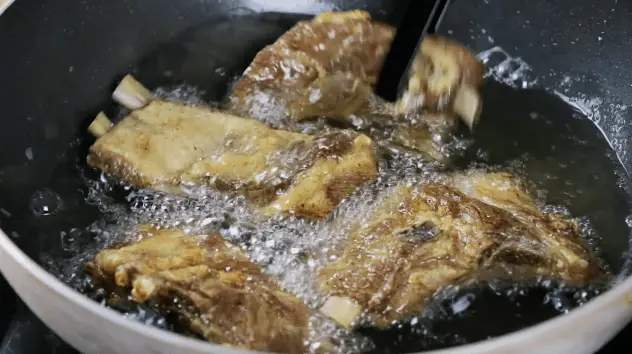
- Remove the pork belly from the kawali and drain the oil in a colander or with paper towel. Then allow to cool completely.
- Reheat the same oil over moderate heat and deep fry the pork belly once more for around 5 minutes or until golden brown. Crispy blisters should appear on the skin. Drain the meat on paper towels.
- Chop the bagnet to serving pieces and serve immediately with a selection of sukang Ilokos or tomatoes and onions with bagoong isda dip or alamang.
Bagoong alamang tomato dip
- Combine your tomato, onion, and bagoong alamang in a bowl, and mix well. Then add the lemon juice and the ground black pepper.

- Continue to mix until well blended and you're ready to serve it alongside your crispy bagnet.

Video
Nutrition
Ingredients used
You can find a quality piece of pork belly at the butcher shop. Quality will get you far in this recipe to get a very, very tasty bagnet.
The other thing is the dip you serve along with it.
Bagnet as traditionally eaten in Ilocos is served with hot steamed rice. But what’s even more satisfying than hot steamed rice is sliced ripe tomatoes, chopped red onions, and citrusy bagoong alamang (or shrimp paste) from the calamansi.
You might not find bagoong alamang in most stores, but this is my favorite one:
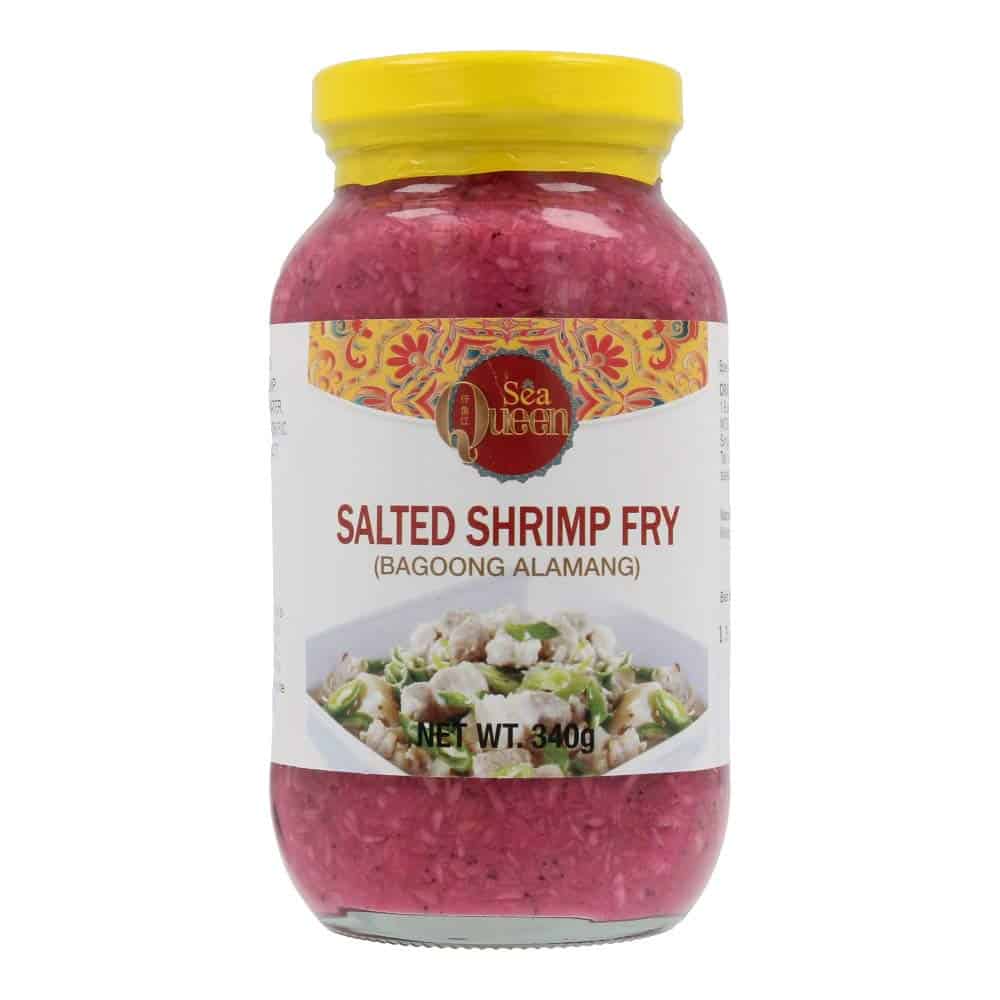
Some prefer the classic vinegar dip as a side; you can check that out in our chicharon bulaklak recipe.
The vinegar dip is also very simple to make. It’s just a mixture of vinegar, chopped garlic, onions, salt, pepper, and some chilies. It adds a little more spiciness to the dish!
Also, try our ampalaya with alamang recipe
Bagnet techniques
According to the locals of Ilocos, the secret to achieving a crispy bagnet is to make sure the pork is dry after cooking it in water with pamintang buo (whole peppercorns) when you deep-fry it.
Another bagnet trick is to deep-fry it twice. Doing this will give you that crackling sound when you bite into it!
Just like any deep-fried foods, bagnet is best eaten while it’s still piping hot. But if you happen to have leftovers, you could always keep those inside the fridge or even the freezer if you’re planning to use them in the future.
How do you reheat bagnet?
The final part of making your bagnet is to deep-fry it a second time, so reheating it is actually the last part of the process! When making bagnet to eat later, you stop after the first frying, and this actually is how you’d buy it at the market as well.
How do you fry frozen bagnet?
Making a ready-to-eat bagnet from your frozen bagnet is as simple as taking it out of the freezer and frying it completely submerged in oil for around 5 minutes. You don’t even have to thaw it first!
The best way to eat bagnet
The best way to eat these is to devour the bagnet and the tomato-onion side dish using your bare hands.
Yep, that’s the only way that you can truly indulge in the goodness and richness of bagnet!
But there are other ways you can enjoy your bagnet, as some add it as toppings to their favorite salad recipe. Or they use bagnet in a favorite vegetable dish like “pinakbet”, which is also very prevalent in the Ilokanos diet.

How long does bagnet last?
Because bagnet is fried twice, you can easily keep your cooked and fried pork liempo in the fridge to finish off frying at a later time. This is even how you buy pre-fried bagnet at the market (to finish off at home).
Keep it in the fridge and it can last for up to a week.
What is the difference between bagnet and lechon kawali?
Bagnet and lechon kawali are both deep-fried pork belly dishes. Bagnet comes from Ilocos, whereas lechon kawali is known as a generic Filipino dish. The bagnet frying process is slow on low heat and fried twice just before serving, whereas lechon kawali uses a fast deep-fry on high heat.
Why is it called bagnet?
The Iloncano bagnet (most often referred to as just bagnet) is pre-boiled pork belly, deep-fried twice to get a golden-brown crispy pork liempo texture. Bagnet originated in Narvacan, a town in Ilocos Sur where there’s even a “Bagnet Festival” that’s held annually.
What is pupor bagnet?
Pupor bagnet is deep-fried pork, just like other bagnet, only it uses the back fat as well. It’s also often referred to as the “Batangas-style chicharon”.
Give bagnet a try
Now that you know what bagnet is and how to make it, it’ll be the perfect dish to try next. So buy some quality pork and get to cooking.
Enjoy our bagnet recipes!
Also read: Pancit luglug recipe with shrimp and crackling pork
Check out our new cookbook
Bitemybun's family recipes with complete meal planner and recipe guide.
Try it out for free with Kindle Unlimited:
Read for freeJoost Nusselder, the founder of Bite My Bun is a content marketer, dad and loves trying out new food with Japanese food at the heart of his passion, and together with his team he's been creating in-depth blog articles since 2016 to help loyal readers with recipes and cooking tips.
